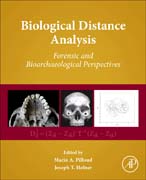
Biological Distance Analysis: Forensic and Bioarchaeological Perspectives
Pilloud, Marin A.
Hefner, Joseph T.
Biological Distance Analysis: Forensic and Bioarchaeological Perspectives synthesizes research within the realm of biological distance analysis highlighting current work within the field and discusses future directions. The book is divided into three main sections. The first section clearly outlines data sets and methods within biological distance analysis beginning with a brief history of the field and how it has progressed to its current state. The second section focuses on approaches using the individual within a forensic context, including ancestry estimation and case studies. The final section concentrates on population-based bioarchaeological approaches, providing key techniques and examples from archaeological samples. The volume also includes an appendix with additional resources available to those interested in biological distance analyses. Defines datasets and how they are used within biodistance analysisApplies methodology to individual and population studiesBridges the sub-fields of forensic anthropology and bioarchaeologyHighlights current research and future directions of biological distance analysisIdentifies statistical programs and datasets for use in biodistance analysisContains cases studies and thorough index for those interested in biological distance analyses INDICE: Section 1. Biodistance Data, Datasets, and Analytical Methods Chapter 1: A history of biological distance analysis Chapter 2: Biological distances and population genetics in bioarchaeology Chapter 3: Craniometric datasets in biological distance Chapter 4: Advanced methods in 3D craniofacial morphology analysis Chapter 5: Cranial nonmetric and morphoscopic datasets Chapter 6: Dental morphology in biodistance analysis: bioarchaeological and forensic applications Chapter 7: Dental metrics in biodistance analysis: bioarchaeological and forensic applications Chapter 8: Do biological distances reflect genetic distances? A comparison of craniometrics and genetic distances at local and global scales Chapter 9: Missing data imputation methods and their performance with biodistance analyses Section 2. Biodistance in a forensic setting Chapter 10: Forensic classification and biodistance in the 21st Century: why the machines will take over Chapter 11: The applicability of cranial nonmetric traits to forensic ancestry estimation: reference data, statistical methods, and theoretical implications Chapter 12: Biological distance, migrants, and reference group selection in forensic anthropology Chapter 13: The craniometric implications of a complex population history in South Africa Chapter 14: The complexity of assessing migrant death place of origin Chapter 15: A multiple classifier system approach to determining ancestry of fragmentary remains: a preliminary study of the Mississippi state asylum cemetery sample Chapter 16: Biological distance analysis, cranial morphoscopic traits, and ancestry assessments in forensic anthropology Section 3. Biodistance and population studiesChapter 17: Postmarital residence analysis Chapter 18: Population structure during the collapse of the Moche (AD200-850): a comparison of results derived from deciduous and permanent tooth trait data from San Jose de Moro, Jequetepeque Valley, Peru Chapter 19: Alternate methods to assess phenetic affinities and genetic structure among seven South African Bantu? groups based on dental nonmetric data Chapter 20: Crossroads of the Old World: dental morphological data and the evidence for a Eurasian cline Chapter 21: Dominance in dental morphological traits: Implications for biological distance studies Chapter 22: A baffling convergence: tooth crown and root morphology in Europe and New Guinea Chapter 23: Population biodistance in global perspective: Assessing the influence of population history and environmental effects on patterns of craniomandibular variation Chapter 24: A biodistance analysis of mandibles from Taiwan, Asia, and the Pacific: a search for Polynesian origins Chapter 25: The biocultural evolution in the Osmore Valley: morphological dental traits in Pre-Inca populations
- ISBN: 978-0-12-801966-5
- Editorial: Academic Press
- Encuadernacion: Cartoné
- Páginas: 518
- Fecha Publicación: 04/08/2016
- Nº Volúmenes: 1
- Idioma: Inglés
